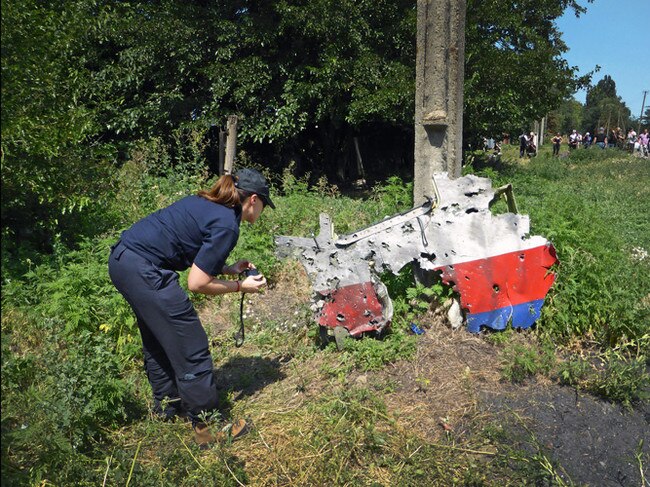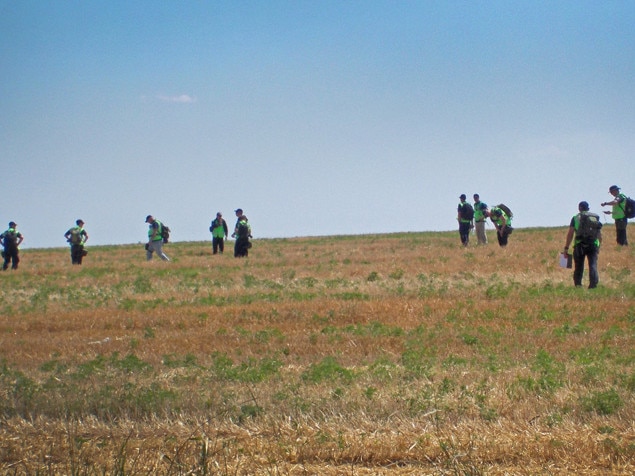Why the MH17 probe was the AFP’s toughest assignment
With bombs and bullets being fired in the background, this is how a team of Aussie police worked tirelessly to help establish who shot down flight MH17 and why.
When MH17 was confirmed down, within 48 hours the first of what would be the largest deployment of Australian police and intelligence personnel since the Asian tsunami and Bali bombing tragedies a decade earlier, were dispatched.
The team of more than 250 personnel, under the codenamed Operation Arew, made it to Ukraine but like the equally sized investigation teams from other nations with passengers on board, were prevented from entering the conflict zone where the Netherlands to Malaysia flight had gone down killing all 298 on-board including 38 Australian citizens and a further two people who called Australia home.

By the time they did go in several days later for a strictly limited time under dangerous warlike conditions,much of the evidence had been tainted, pilfered, destroyed or all of the above.
What has then had to follow in the almost five years since the July 17, 2014 crash, has been nothing short of a forensic investigative miracle to come up with a result that hopefully will bring some sense of justice and closure to the victims and families affected by this tragedy.
MH17 probe findings to be revealed to families
MH17 crash suspects to be named: reports

In 2015 the Joint Investigations Team, which included predominantly Dutch, Belgian and Australian senior investigators, were able to present to the world the literally painstakingly pieced together sections of fuselage to show how the aircraft came down and now another four years later we know by whose hand.
The latter task was gathered amid the reluctance by at least one nation, Russia, to offer evidence it possessed and what it did provide was befuddled and inconsistent with the few facts that were not in dispute.
The fact was the Malaysian Airlines flight was brought down by a Buk missile from Russia’s 53rd Anti-Aircraft Missile Brigade in Kursk but who used the launcher remained unknown until now.
MH17: Russian probe hack claim
How Malaysia hindered the MH17 investigation
There were many heroic efforts in Arew and its never-used-before investigative techniques with AFP commanders Brian McDonald and Mark Harrison standouts as was AFP’s chief scientist and disaster victim identification specialist Dr Simon Walsh. And of course retired Australian Defence Force Air Chief Marshal Angus Houston who led recovery efforts. All four men later said the assignment was the toughest of their individual distinguished careers.
News Corp Australia was instructed not to discuss assistance it provided investigators but we can reveal we had spent 10 hours over two days on two separate occasions providing first-hand accounts of what we saw as one of the first Western media crews at one of the three crime sites within the 50 square kilometres radius of the crash.
We were able to provide evidence from the still-smoking cockpit scene which authorities could not reach before militia-backed crews swept through and used powered metal saws, grinders and cables to cut the plane up in pieces for removal — in part with human remains and personal belongings still present. We also photographed documentation from the cockpit including flight log books, flight charts and maps, written flight observations by vice-captain Muhamed Firdaus Abdul Rahim and other material we considered might be critical to investigators at a later stage. Much of this actual evidence was lost after this time.
Critically, we were also able to provide investigators with a 17-minute raw video and audio that had been recorded by the militia itself as it trawled through the burning wreckage of the aircraft minutes after it was shot down, ostensibly as the group sought to find a military crew of what they thought had been a Ukraine military aircraft. On it were the incriminating faces and voices of separatist militia and Russian identities linked to the tragedy, most of whom have now been identified.
It was a small contribution to a very much large puzzle of tens of thousands of extraneous material investigators have had to complete to put a face to those responsible for this.
The Australian Government last year set aside $50 million to go toward the prosecution of those responsible for the tragedy as well as to assist the families of the victims wanting to attend proceedings at The Hague.
For many the tragedy will last a lifetime, but hopefully putting someone in the dock now will go some way to bringing some closure.


